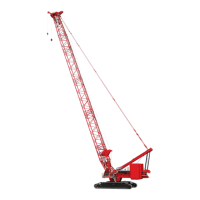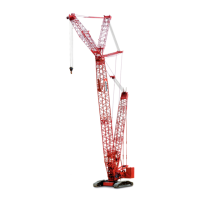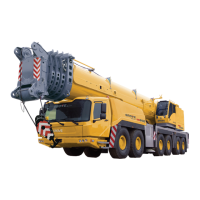UNDERCARRIAGE MLC300 SERVICE/MAINTENANCE MANUAL
8-2
Published 11-22-17, Control # 257-02
Travel Brake Operation
See Figure 8-1 and Figure 8-2 for the following information.
The travel brakes are a spring-applied, hydraulically
released brake system located between each travel motor
and its corresponding planetary drive. The travel brake must
be actively released by the control system. If the brake
hydraulic pressure or electrical control is lost, the brake is
applied by spring force.
The travel brake release system uses charge pressure from
pump 2, supplied to the travel brakes via the travel brake
release solenoid valve. The brake release pressure must be
at least 17 bar (246 psi) to fully release the brakes. If the
pressure is less than 17 bar (246 psi), the brakes could
remain partially applied, which could damage the brake
system.
Travel Park Brake Disengaged
Joystick J2 sends 24 V
DC
to the travel park switch. The
travel park switch is closed in the UN-PARK position,
causing the switch to send 24 V
DC
back to joystick J2. When
24 V
DC
is detected, joystick J2 activates the travel control
handles, but does not allow the travel park brake to
disengage until one or both travel control handles are
moved.
When a travel control handle is moved, either forward or
rearward, joystick J2 sends the disengage park brake
command to the CCM-10 control module via CAN Bus A.
The CCM-10 control module relays the command to the
CCMB11 control module via CAN Bus C. The CCMB11
control module then sends 24 V
DC
to the travel brake
release solenoid valve, energizing the solenoid. The
solenoid valve shifts position, routing hydraulic fluid to the
travel brakes, releasing the brakes.
Travel Park Brake Engaged
When the travel park switch is moved to the ON-PARK
position, the travel park switch is open, sending 0 V
DC
back
to joystick J2. When 0 V
DC
is detected, joystick J2
deactivates the travel control handles and sends the engage
park brake command to the CCM-10 control module via CAN
Bus A. The CCM-10 control module relays the command to
the CCMB11 control module via CAN Bus C.
The CCMB11 control module then sends 0 V
DC
to the travel
brake release solenoid valve, de-energizing the solenoid.
This causes the solenoid valve to return to the default
position, allowing the hydraulic fluid in the brake system to
flow through the travel brake release solenoid valve, then
back to the tank. The reduced hydraulic pressure allows
spring force to apply the travel brakes.
Travel Speed Selection
See Figure 8-1 and Figure 8-2 for the following information.
Low Travel Speed
The SCM-00 control module sends 24 V
DC
to the travel
speed switch. When the switch is in the LOW speed position,
the switch is open, sending 0 V
DC
back to the SCM-00
control module. The SCM-00 control module communicates
the low-speed command to the CCM-10 control module via
CAN Bus A.
The CCM-10 control module then sends a corresponding
signal to the IOSB22 control module via CAN Bus B. The
IOSB22 control module then decreases the pulse width
modulation (PWM) duty cycle to the travel motor control
solenoids. The decreased PWM duty cycle increases the
angle of the motor swashplate, causing the motor speed to
decrease. Motor displacement goes to maximum.
When in low-speed travel mode, the travel motors are kept at
maximum displacement and any variation in travel speed is
done by varying the PWM duty cycle to the pump control
solenoids.
High Travel Speed
When the travel speed switch is in the HIGH speed position,
the switch is closed, sending 24 V
DC
back to the SCM-00
control module. The SCM-00 control module communicates
the high-speed command to the CCM-10 control module via
CAN Bus A.
The CCM-10 control module then sends a corresponding
signal to the IOSB22 control module via the CAN Bus B. The
control algorithm commands the CCM-10 and IOSB22
control modules to drive the travel pumps and motors at a
higher rate of speed relative to the movement of the travel
control handles.
When in high-speed travel mode, the IOSB22 control module
varies the PWM duty cycle to the travel motor control
solenoids as commanded by the control algorithm.
Increasing the PWM duty cycle decreases the angle of the
motor swashplate, causing the motor speed to increase.
NOTE: When the load on the travel circuit increases, the
control algorithm decreases the PWM signal to the
motors. This causes the angle of each motor’s
swashplate to increase, which increases motor
displacement. The motors rotate at a slower speed,
but with more torque.

